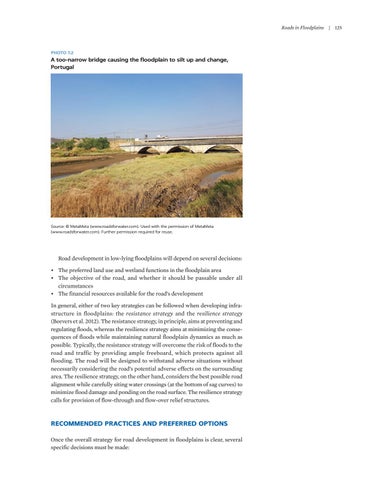Roads in Floodplains | 125
PHOTO 7.2
A too-narrow bridge causing the floodplain to silt up and change, Portugal
Source: © MetaMeta (www.roadsforwater.com). Used with the permission of MetaMeta (www.roadsforwater.com). Further permission required for reuse.
Road development in low-lying floodplains will depend on several decisions: • The preferred land use and wetland functions in the floodplain area • The objective of the road, and whether it should be passable under all circumstances • The financial resources available for the road’s development In general, either of two key strategies can be followed when developing infrastructure in floodplains: the resistance strategy and the resilience strategy (Beevers et al. 2012). The resistance strategy, in principle, aims at preventing and regulating floods, whereas the resilience strategy aims at minimizing the consequences of floods while maintaining natural floodplain dynamics as much as possible. Typically, the resistance strategy will overcome the risk of floods to the road and traffic by providing ample freeboard, which protects against all flooding. The road will be designed to withstand adverse situations without necessarily considering the road’s potential adverse effects on the surrounding area. The resilience strategy, on the other hand, considers the best possible road alignment while carefully siting water crossings (at the bottom of sag curves) to minimize flood damage and ponding on the road surface. The resilience strategy calls for provision of flow-through and flow-over relief structures.
RECOMMENDED PRACTICES AND PREFERRED OPTIONS Once the overall strategy for road development in floodplains is clear, several specific decisions must be made:







































